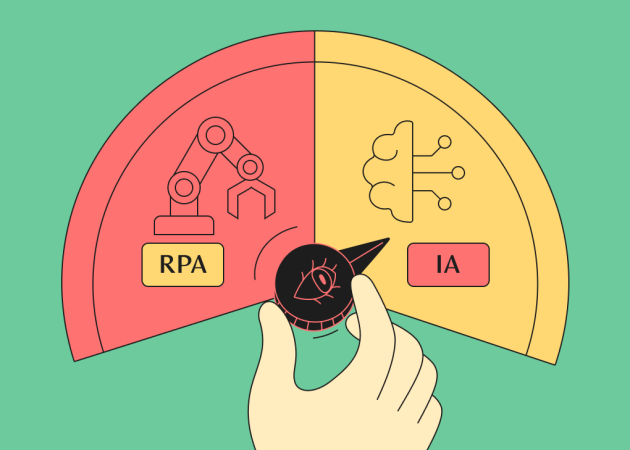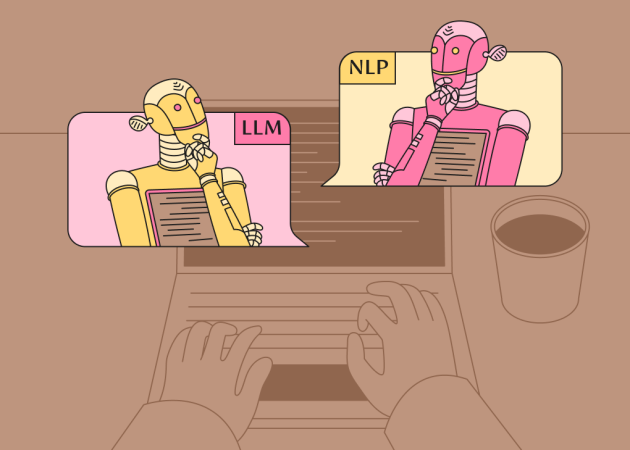
RPA vs. Intelligent Automation: Know the Difference to Choose Right
Contents
Contents
Robotic process automation services had been a buzzword for a while until intelligent automation replaced it. Now, many enterprises consider using AI-based automation as a more innovative and efficient approach. But is it really so?
RPA showed tangible results for 55% of organizations, which is far from perfect, but still significant. It enables businesses to automate many standard operations and significantly improve performance. Bots take on rule-based and repetitive tasks, allowing employees to focus on more complex operations. Intelligent automation goes a step further. It combines the strengths of RPA with artificial intelligence for end-to-end automation.
Intelligent automation vs. robotic process automation are closely related, as both are necessary at different stages of automating operations within an enterprise. They are often combined for more comprehensive optimization and complement each other.
What Is Robotic Process Automation (RPA)?
Robotic process automation (RPA) is the use of technologies to automate basic repetitive operations. Software robots mimic human actions, such as data extraction, typing, or moving files, based on scripts. They interact with applications within a software system through APIs and user interfaces, just like a human user would do.
This type of automation relies on preset rules and the use of structured data with a consistent format and location. The most common use cases involve high-volume, repetitive tasks that do not require a deep understanding of context and are relatively simple. Automated invoicing, financial reporting, payroll processing, data management, and order management are typical examples of RPA applications.
What Is Intelligent Automation (IA)?
Intelligent automation (IA) is the use of artificial intelligence (AI), robotic process automation (RPA), and business process management (BPM) technologies for end-to-end automation. This approach enables the automation of complex operations that require unstructured data processing, decision-making, and continuous learning.
It’s the next-level automation, also known as hyperautomation, which involves automating workflows across an entire organization. By powering RPA with AI, intelligent automation covers both repetitive, rule-based tasks and cognitive tasks that require more advanced technologies, including machine learning models (ML) and natural language processing (NLP). Intelligent automation systems involve human supervision when judgment-based, creative, or ethical decisions are necessary.
RPA vs. Intelligent Automation: Key Differences Explained
RPA is the foundation of intelligent automation that is suitable for simpler tasks. The primary difference is that RPA adheres to specific rules, whereas intelligent automation makes decisions based on a complex combination of factors. RPA automates a task only if you directly instruct it to. IA can figure out how to complete a task on its own from the broader context and previous interactions. In other words, intelligent automation is smarter. Below are some additional aspects showing the difference between RPA and intelligent automation.
Technologies
The typical toolkit of engineering teams building RPA systems includes UiPath, Automation Anywhere, and Blue Prism. These are necessary to design and deploy chatbots for rule-based decisions. You will also need solutions for screen scraping, GUI automation, and integrating the bot with existing systems.
Intelligent automation software is more demanding. It combines RPA technologies with a broader AI stack, which may include machine learning (ML), natural language processing (NLP), or computer vision (CV) technologies, depending on the specific functionality. The infrastructure is also more sophisticated, including cloud platforms, virtual machines, databases that store both structured and unstructured data, and IoT devices for real-time automation.
Decision-making process
This one is the main difference between automation and RPA. RPA systems operate based on predefined rules and have no flexibility. If you instruct them to send a greeting message to each new customer, they send the same message to everyone. They also cannot handle exceptions and require predictable workflows. When comparing RPA vs. intelligent automation, IA systems are more creative. They process large amounts of structured and unstructured data with AI to run analytics, detect patterns, and make context-aware decisions. They keep working under unusual conditions and escalate to humans only when the risks are high.
Type of input
The choice between intelligent process automation vs. RPA largely depends on the type of data you have. Since RPA systems are rule-based, they run correctly only if you feed them with structured data (e.g, forms, spreadsheets). It must have a strict, predefined format and be stored in a structured system, such as a relational database or data warehouse. Conversely, intelligent automation systems can handle both structured and unstructured data, thanks to their AI capabilities. They can process text, images, emails, and voice messages with high accuracy. In other words, intelligent process automation typically has broader coverage and supports various types of input.
Human supervision
Both robotics and intelligent automation cannot operate without a human-in-the-loop, but the extent of involvement differs. RPA systems automate only repetitive tasks and require human support for all unusual cases. Things like system updates or changes in data formats can disrupt the work of RPA and require human intervention. IA systems are more independent and require less supervision. They learn from data and self-improve, engaging human support only when AI capabilities are not enough. This is usually when they face exceptions, need human judgment, creativity, or empathy.
Improvement and learning
RPA systems have no learning capabilities. They are like a reliable and stable worker who does exactly what you tell them to do, never breaking the rules. IA software is more flexible. It relies on AI/ML models that are trained on new data and continuous feedback. The system considers the outcome of its previous decisions and adapts accordingly.
Implementation and training approach
RPA systems operate based on predefined rules. Therefore, to implement them, engineering teams need to select a repetitive process that can be broken down into stages. They document the specific rules (e.g., “if the invoice is up to $150, approve it”) and configure the bot accordingly. The bot follows the same if-then logic for all future cases.
For AI software, you need a more elaborate implementation and training approach. It’s necessary to gather data from multiple sources, select the appropriate AI/ML model based on the task type, and train it using the collected data. The training process is time-consuming, involving multiple iterations and testing.

Business Value: When to Use Robotic Process Automation vs. Intelligent Automation
Although it may appear that intelligent automation delivers better results, in some cases, robotic process automation is more effective. Not every process requires contextual understanding and dynamic adaptation. Many operations are repetitive and can benefit from basic automation.
Benefits and uses of RPA
Robotic process automation ensures optimal outcomes when you have predictable input and want predictable output. Consider this approach to:
- Automate repetitive processes. Great for back-office tasks such as data entry or report generation.
- Achieve quick cost savings. Increases productivity and ROI since staff can be assigned to more demanding tasks.
- Higher accuracy and compliance. Predictability and transparent workflows ensure the systems deliver the same output each time and help achieve regulatory compliance.
- Existing systems remain in place. Implementation does not disrupt existing systems since bots run on their presentation layer.
- Reduce manual labor costs. Covers many standard operations, allowing companies to cut repetitive processes and save costs.
Benefits and uses of IA
When comparing intelligent automation and robotics, the impact of AI is more far-reaching. Intelligent automation is a part of a comprehensive digital transformation that requires more resources, but also has a more profound effect. The main reasons to implement IA include:
- Decision-making tasks. Covers tasks that require advanced analytics to make decisions, like approving a loan or flagging fraud.
- Automate operations that involve unstructured or semi-structured data. Processes multiple types of data to handle complex operations such as interpreting emails or monitoring product manufacturing quality.
- Implement systems with continuous learning. Relies on machine learning to improve the accuracy and relevance of output.
- Workforce augmentation. Provides human workers with smart insights for real-time analytics and better informed decisions.
- Strategic automation. Allows businesses to achieve a higher level of automation and scalability across multiple operations, from document management to production.
Intelligent Automation vs. RPA in Practice: Use Cases & Real-World Examples
Both intelligent process automation vs. robotic process automation are adopted across industries. The decision on which approach to use mainly depends on the company type, use cases, and the extent of automation.
Overall, intelligent automation works well in systems with complex workflows that frequently change and require flexibility. The typical use cases include automotive manufacturers, pharma companies, insurance providers, and healthcare systems. RPA is better for operations that require predictability, like finance, retail, and document management.
Real cases of RPA implementation:
- Finances. According to Forrester’s report, 1 in 3 bots is currently used in finance. Banks apply RPA automation to streamline the manual entry of large data volumes. They are also helpful to automate account opening, customer research, and inquiry processing.
- Healthcare. Helse Vest applies RPA to reduce the administrative burden on its medical staff, allowing them to concentrate on patient care rather than document management. It automatically extracts information from XMLs, updates it in the systems, and removes outdated entries, saving time equivalent to 1.5 staff members.
Real cases of IA adoption
- Order fulfillment. World Wide Technology (WWT) partnered with Centric Consulting and UiPath to implement AI-based automation for vendor order fulfillment systems. The company trained an ML model based on over 150 PO to recognize the necessary information by its characteristics. It has enabled the company to better manage high volumes of purchase orders in numerous formats and languages.
- Food and beverage production. A food and beverage producer uses AI-powered automation to analyze product images and flag discrepancies. Once it detects an issue, it notifies the responsible department. It ensures the accuracy of labels and compliance with design standards, considerably saving time for inspections.
- Greentech. Hydrogen Pro collaborated with Beetroot to innovate its climate tech equipment manufacturing process with an AI-powered solution. The production data system automatically identifies and traces documentation, connecting it directly to the production process.
How Intelligent Automation and RPA Work Together
Robotic process automation vs. intelligent automation complement each other as they cover different types of operations. While RPA robots automate rule-based tasks, AI automates activities that require learning and context-based decision-making. By integrating RPA vs. automation, enterprises can build systems with more comprehensive automation, from basic tasks to advanced operations.
Combining RPA with AI technologies, for example, Azure AI services, is a common way to upgrade existing systems. RPA automates repetitive tasks. AI services bring natural language processing, machine learning, and computer vision for operations that require more complex data analysis.
A typical scenario is when RPA bots execute decisions made by AI. For example, an automotive manufacturer can implement intelligent automation through computer vision-based systems that detect defects and automate report generation using RPA rules. Another example is when predictive analytics forecasts the demand based on historical data and trends, while RPA automates ordering.

Implementation Strategy: From RPA to Intelligent Automation
RPA and intelligent automation are often two stages of a single system’s lifecycle. Many companies that started with robotic process automation are now upgrading it with AI capabilities and more complex workflows to implement intelligent automation. It’s a continuum of digital transformation that does not necessarily involve full automation. According to a Deloitte automation survey, only 8% of organizations believe they are close to being an ideal organization transformed by intelligent automation. Others still have a lot of work to do and may not need to reach maximum automation to meet their business goals.
Developing an optimal RPA-to-IA implementation strategy requires RPA consulting services and careful planning. These are the main steps you can expect to go through when implementing intelligent automation and robotics.
- Identify business goals and opportunities. Consider what you aim to achieve by upgrading RPA to intelligent automation. Focus on strategic goals rather than specific processes (e.g., enhancing customer support quality, reducing production defects, etc.).
- Understand where RPA is not enough. If you already have RPA bots in place, run process discovery to see the limitations and cognitive potential. Define high-impact operations that can be automated with AI technologies. Prioritize the most critical ones and set KPIs to measure the impact of innovations.
- Have a data strategy. Ensure you have high-quality data to train AI/ML models, as it directly impacts the effectiveness of intelligent automation. You may need to prepare data by cleaning, labeling, and annotating it.
- Build an architecture. Map the decision logic and how the new system will operate. Include a human in the loop to monitor the process and double-check automated decisions when critical judgment is required.
- Integrate AI technologies. Connect third-party or custom-developed AI systems for text, speech, image, or intent recognition and customize them based on your unique operations. The selection of AI technologies depends on the nature of tasks you plan to automate.
After you are done with integrating AI, test the automated system, gather feedback, and feed it into the model to fine-tune it. Continuous retraining and learning are essential to keep intelligent automation systems updated and accurate.
What Comes After Intelligent Automation?
AI remains the leading intelligent automation technology, with 46% of executives planning to implement it by 2025 (Deloitte). Process monitoring and process mining share second and third place, with 43% each. At the same time, it’s evident that intelligent automation is not the final stop, at least in its current format. AI keeps getting smarter, providing organizations with new ways to enhance their systems.
Autonomous AI agents are commonly viewed as a successor to intelligent automation. These systems independently perceive environments, learn from previous decisions, and most importantly, build and execute multi-step action plans without close human oversight. They still require supervision, but AI agents, compared to traditional automation tools, can handle more complex and often ambiguous problems on their own. While intelligent automation systems are task-based, agentic AI focuses on specific goals and figures out how to achieve them.
Agentic AI is not going to replace intelligent automation entirely. Organizations can layer them onto existing RPA and IA systems to expand the functionality and maximize efficiency. Just like IA is the next step after RPA, agentic AI is an upgrade from intelligent automation.
Decide What Works for You: RPA vs. AI
One key thing from this overview is that intelligent automation and RPA are not mutually exclusive. Intelligent automation vs. RPA are different stages of software system automation. RPA is more suitable for companies that are making their first steps in automation, have limited budgets, or focus on optimizing repetitive operations. Intelligent process automation is considered the next-level approach. It works well for larger enterprises that want to streamline operations that require real-time decision-making and contextual understanding. IA systems have rule-based automation as well, but they also include more sophisticated technologies such as AI and business process automation.
If you still doubt what to choose, robotic process automation vs. intelligent automation, our engineering team can provide guidance. Contact us to schedule a session and get advice from experienced RPA and IA implementation engineers. We will offer a tailored automation strategy based on your business needs and available resources.
FAQs
What is the main difference between RPA and IA?
Robotic process automation (RPA) is a rule-based technology that requires structured data and makes decisions following the exact instructions. RPA systems work well for repetitive tasks. Intelligent automation (IA) combines artificial intelligence (AI), robotic process automation (RPA), and business process automation (BPA) to make decisions based on real-time context and learns from previous interactions.
Is Intelligent Automation just RPA with AI?
No, intelligent automation is a broader concept than adding AI capabilities to an RPA system. It combines AI insights with workflow automation for non-linear tasks and context-based decisions. Intelligent automation not only completes actions like RPA systems, but also thinks and learns from the outcome.
Can I upgrade my existing RPA bots to Intelligent Automation?
Yes, it’s a common practice to expand the functionality of an RPA system with AI. You can analyze the limitations of your current chatbots, clarify how AI technologies can provide the necessary capabilities, and implement them for the specified operations.
Which is better for small business: RPA or IA?
RPA is a simpler and more affordable option, which makes it a popular choice for small businesses with limited budgets. You can start with RPA and gradually increase the extent of automation through AI implementation, if your company truly benefits from it. However, there is no universal solution for everyone, and the approach should depend on your business specifics and potential investment.
What are the main components of an Intelligent Automation system?
An IA system includes three cognitive technologies: artificial intelligence (AI), business process management (BPM), and robotic process automation (RPA). The AI component enables complex data analysis and serves as a decision engine. BPM automates workflows and business processes. RPA uses software robots to manage back-office tasks, complementing other components.
Is cognitive automation the same as intelligent automation?
Although cognitive and intelligent automation are often used interchangeably, they slightly differ. Intelligent automation is a broader term that includes cognitive automation as a subset. While IA automates non-routine tasks in complex systems through both rule-based and cognitive capabilities, cognitive automation focuses on the thinking aspect and how software mimics human thinking.
Subscribe to blog updates
Get the best new articles in your inbox. Get the lastest content first.
Recent articles from our magazine
Contact Us
Find out how we can help extend your tech team for sustainable growth.







